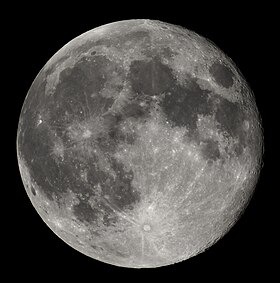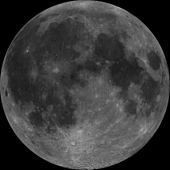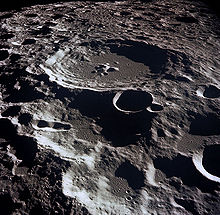Cards In This Set
| Front | Back |
|
The Moon is Earth's only natural satellite and is the fifth largest satellite in the Solar System. It is the largest natural satellite in the Solar System relative to the size of its planet.The Moon's current orbital distance, about thirty times the diameter of the Earth, causes it to be the same size in the sky as the Sun – allowing the Moon to cover the Sun precisely in total solar eclipses.
|
 |
|
The United States' NASA Apollo program achieved the only manned missions to date, beginning with the first manned lunar orbiting mission byApollo 8 in 1968, and six manned lunar landings between 1969 and 1972 – the first being Apollo 11 in 1969. These missions returned over 380 kg of lunar rocks.
|
 |
|
The Moon is in synchronous rotation: it rotates about its axis in about the same time it takes to orbit the Earth. This results in it nearly always keeping the same face turned towards the Earth. The Moon used to rotate at a faster rate, but early in its history, its rotation slowed and became locked in this orientation as a result of frictional effects associated with tidal deformations caused by the Earth.The side of the Moon that faces Earth is called thenear side, and the opposite side the far side. The far side is often inaccurately called the "dark side," but in fact, it is illuminated exactly as often as the near side: once per lunar day, during the new Moon phase we observe on Earth when the near side is dark.
|
 |
|
Liquid water cannot persist at the Moon's surface, and water vapour quickly evaporates, breaks up through photodissociation due to sunlight, and is lost to space. However, scientists have thought since the 1960s that water ice, deposited by impacting comets or produced by the reaction of oxygen-rich lunar rocks and hydrogen in the solar wind, could survive in the cold, permanently shadowed craters at the Moon's poles.
|
 |
|
Eclipses can only occur when the Sun, Earth, and Moon are all in a straight line.Solar eclipses occur near a new Moon, when the Moon is between the Sun and Earth. In contrast, lunar eclipses occur near a full Moon, when the Earth is between the Sun and Moon. The angular diameters of the Moon and the Sun as seen from Earth overlap in their variation, so that both total and annular solar eclipses are possible. In a total eclipse, the Moon completely covers the disc of the Sun and the solar corona becomes visible to the naked eye. Since the distance between the Moon and the Earth is very slowly increasing over time, the angular diameter of the Moon is decreasing. This means that hundreds of millions of years ago the Moon would always completely cover the Sun on solar eclipses, and no annular eclipses were possible. Likewise, about 600 million years from now (if the angular diameter of the Sun does not change), the Moon will no longer cover the Sun completely, and only annular eclipses will occur.
|
 |



